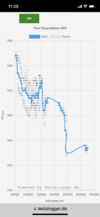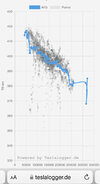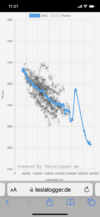To switch to a new discussion, at what point do you think we should start thinking more about the impact of cyclic aging? Does this vary by the mileage?
More or less never, for the average car.
First; In general both the cyclic and calendar aging is lowest at low SOC.
So both benefit from about the same charging habits.
This is cells from a 2018 model 3 in a test:
The 21700 cells were extracted from a battery pack of a relatively new Tesla 3 Long Range from the year 2018. The cells were cycled within 0-50%, 50-100% and 0-100% SoC ranges at constant temperatures: at 22°C and 45°C correspondingly
Research report
For us, this test is not the very best as it includes the end points 0 (true 0%) and 100% in all cycle ranges. A bit unusual that the high SOC range was the best, but we have seen quite varying results with NCA research tests, so we should probably not go too hard on this result. (The researchers promise to be back with new tests with smaller DoD range cycles. This will be interresting.)
Well, the picture shows worst case 20% loss at 750 (FCE) cycles. That is 300.000km in my car.
A average EV car might do 20K km or 13K mi per year?
This means we get 20K/300K x 20% = 1.33% cyclic degradation per year.
This is the worst case scenario.
The best case scenario in the test is 2500 FCE until 20% loss, so 1000K km which gives us 0.4% cyclic aging per year.
For the test cycles in this research I would say they are not applicable on real charging/driving conditions so in real life we use leas charging power and the most important much less average power.
C/3 and 1C current rates were used as charging and discharging current respectively
C/3 for charging is about the higher limit where we can call it “safe”. (C/3 equals about 25 kW charging power).
Discharge at 1C is about 78kWh and means that we would deplete the battery until the car stops in one hour.
So compared to real life, these tests show higher degradation then we would actually see. They also (most probably) did not reduce the test results with the calendar aging. These cycles graphs most probably include the calendar aging that happend during the time of the test.
Compared to
This research report we can see and understand that the model 3 cells was cycled a bit too hard, and also to the end points 0% and 100%. Using that report we see that low SOC causes least degradation and the expected loss is about 10% loss for 1250 FCE at 50-10% SOC range and 15% loss for 1000 FCE at 90-10%. This means 0.4 to 0.75% cyclic degradation per year. (Regularly using 90-10% and only driving 20K km each year is not probable.)
So, in general we could call the cyclic degradation about 0.5% annually, OK?
If we use > 60% (65-90%) as the charging target and charge after work daily we get about 5.5% calendar aging the first year.
(From numerous of calendar aging tests)
After 9-10 years you still have about 1% calendar aging that year.
After 15 years you still have 0.7% calendar aging.
Another new discussion: if we successfully maintain low battery degradation in the first 5 years, does battery degradation then flatline at a high remaining capacity or does it over time catch up with degradation in batteries that degraded faster? Let's say a poorly maintained battery loses 15% capacity in the first 5 years and then flatlines at 85% capacity for the subsequent years. A well-maintained battery loses 10% in the first 5 years - does it then flatline at 90% or does it go down to 85% before flatlining?
I’m gonna stick my head out and declare ”flat line” a myth. There is no research for cyclic or calendar aging research supporting this theory. If you look at high mileage graphs from teslafi they are not flat-lining and looking at teslalogger.de on a lot of different charts for high mileage teslas, they do not support this.



I know tesla use a graph that make it look like this, maybe influenced by the teslarati data. I do not believe in that.
In some cases we probably have some older Teslas that stucks at a higher range than the true range. I do not know if this is on purpose from Tesla (they could easily do that if they like). Anyway it is not uncommon to se posts about cars getting stranded just after having 10 miles or 5% or so on the screen. If the car counts wrong and we end up with no juice when the screen shows > 0% just before the stopping, or it drains very fast in the end we probably have a BMS lying to us about the capacity. If this is common it might induce the feeling of less degradation than the true degradation.
Cyclic aging and calendar aging forms SEI that also protects the battery from further degradation. This is the reason for the reduced calendar aging. To some extent cyclic aging might also be less when the battery forms SEI.
The easiest way to explain this is that at a certain degradation level from SEI, the battery is less sensitive, but it still has the sensitivity for different SOC vs calendar aging.
Calendar aging is double at 80% vs 30-55%, and it will continue to be double even when reaching 15% degradation. Calendar aging is overall less, but still double at 80%.





